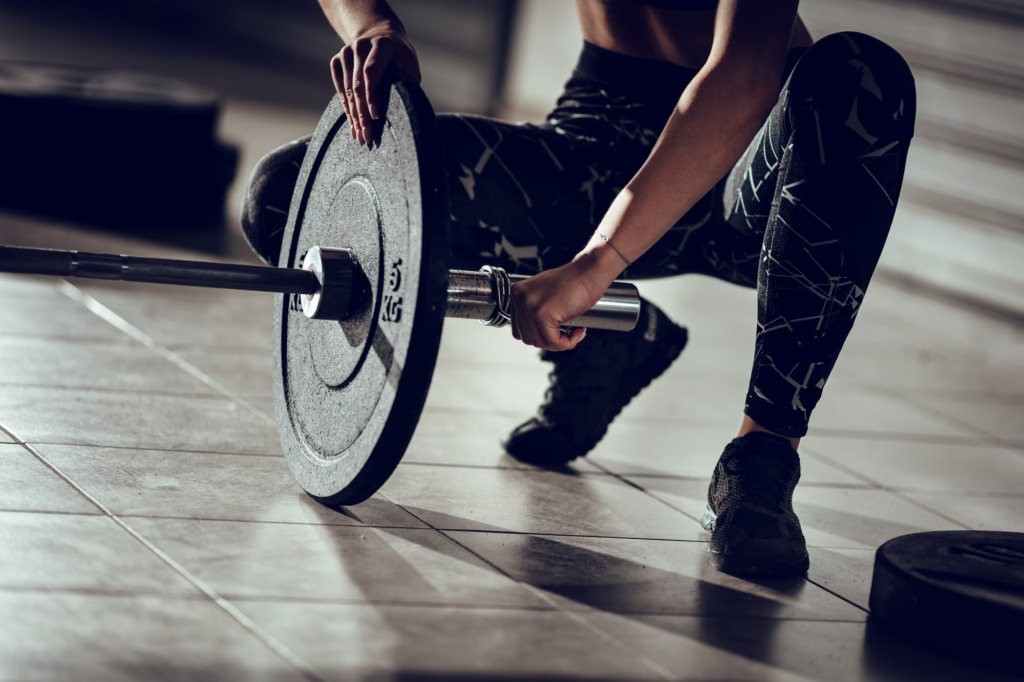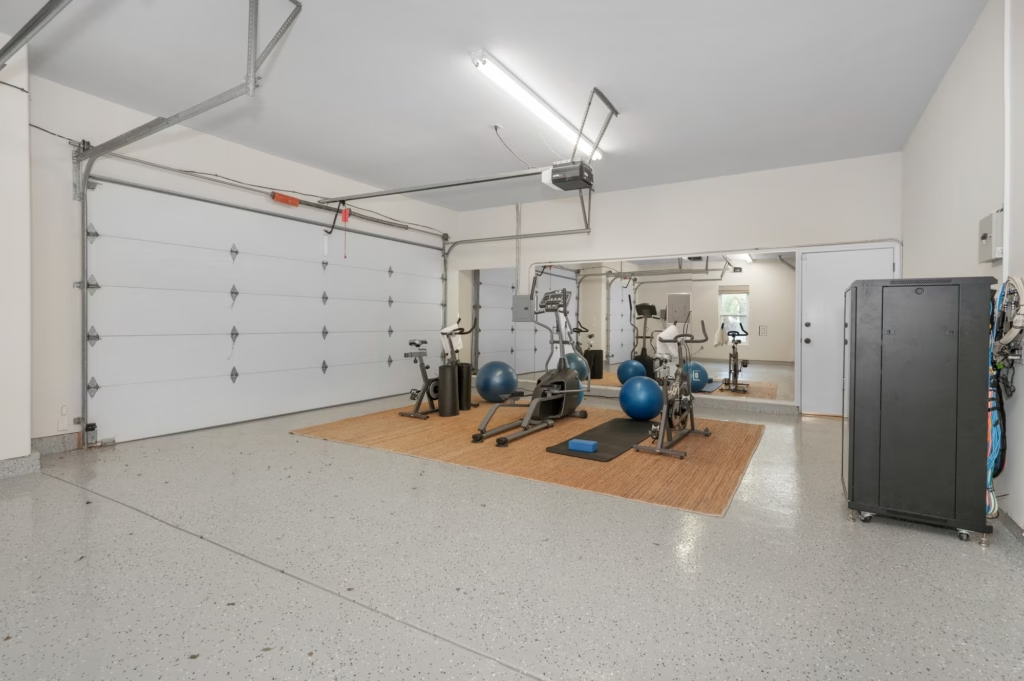CrossFit garage gym setup is both an exciting project and a smart investment for any functional fitness enthusiast. In fact, the number of people working out at home jumped from 24% in 2019 to 34% in 2020 ptpioneer.com, showing that more athletes than ever are creating personal workout spaces. This guide will walk you through exactlyhow to design and equip a CrossFit garage gym that rivals a commercial box – from essential gear and layout tips to budget hacks and safety considerations. By the end, you’ll be ready to set up the ultimate CrossFit garage gym that fits your space, goals, and budget, so you can crush WODs at home with convenience and confidence.
Table of Contents
Planning Your CrossFit Garage Gym Setup (Space & Budget)
CrossFit garage gym setup planning starts with assessing how much room and money you have to work with. As a rule of thumb, aim for at least a 10 ft x 10 ft area (about 3m x 3m) for a functional home gym space
flowwall.com. This gives you enough room for a rack, barbell movement, and conditioning work without feeling cramped. A standard one-car garage or a portion of a two-car garage is usually perfect. If you’re tight on space, don’t worry – creative storage and fold-away equipment (like a wall-mounted folding squat rack) can dramatically increase usable training area.
- Measure Your Space: Mark out your intended gym floor area. Ensure you have clearance for overhead movements (ceiling height ~8-10 ft is ideal for overhead presses and wall balls). Also, check the floor can handle heavy weights or consider reinforcing it if needed (concrete is best, but you’ll add protective mats anyway).
- Set a Budget: Garage gym costs can range widely. You can spend a few hundred dollars for a basic setup or tens of thousands for a dream gym. Many CrossFitters build a very capable garage gym for under $1,500 thebarbellspin.comby carefully selecting essentials. Determine how much you’re willing to invest up front. Keep in mind you can always start small and expand over time. (For example, GetRX’d offers a customi edgeoflongevity.comedgeoflongevity.com reporting around $626 getrxd.com– a great baseline for budget planning.)
- Prioritize Needs vs. Wants: List the equipment you must have to do your favorite WODs (e.g. barbell, plates, rack, pull-up bar) versus nice-to-haves (like an Echo Bike or SkiErg). This will help allocate your budget to the most impactful items first. We’ll cover the essential CrossFit garage gym equipment in the next section.
- Flooring & Environment: Plan to get some rubber gym mats or stall mats to protect your garage floor and your equipment. These also reduce noise when dropping weights. Check for adequate ventilation (open the garage door or use fans) because WODs get sweaty, and coleadmanfitness.comleadmanfitness.com an if your garage isn’t climate-controlled. Good lighting is also important for safety and visibility – bright LED shop lights can turn a dingy garage into a vibrant workout space.
- Check Restrictions: If you’re in a neighborhood or renting, ensure a garage gym is allowed. Most of the time it’s fine, but be mindful of noise (dropping barbells can be loud!) and plan to mitigate sound if needed with padding or by limiting early-morning/O-dark-thirty lifting.
Suggested Image: A cleared garage space with taped outlines of where equipment will go. Alt text: “Empty garage marked for CrossFit gym setup, measuring floor space and layout.”
CrossFit Garage Gym Setup Essentials (Equipment You Need)
When it comes to outfitting a CrossFit garage gym, certain pieces of equipment are absolute game-changers. These core items will allow you to perform a wide variety of CrossFit movements and WODs right at home. Let’s break down the essential CrossFit garage gym equipment and some top options (including tried-and-true gear from Rogue Fitness and GetRX’d):
Barbell and Bumper Plates – Foundation of Strength 🏋️♂️
A quality Olympic barbell is the heart of any CrossFit garage gym setup. Look for a 20kg men’s bar or 15kg women’s bar with good spin and durability. The Rogue Ohio Bar (20kg) is a popular multipurpose choice, known for its balance of whip and strength – perfect for everything from heavy deadlifts to high-rep snatches. (You can find it on Rogue’s site: Rogue Ohio Bar [affiliates: Rogue fitness – great quality, or check GetRX’d for a budget-friendly bar). Consider also a technique bar or training bar if multiple people of different levels will train (or for teens).
To load your bar, bumper plates are a must. These rubber plates can be dropped from overhead safely. A set that includes pairs of 10lb, 15lb (or 15kg technique plates), 25lb, 35lb, and 45lb will cover most workouts. High-temp crumb rubber plates are very durable for outdoor or rough use, while training bumpers or competition plates have a slimmer profile (so you can fit more weight on the bar) and a dead bounce. Rogue’s HG 2.0 bumpers or Echo bumper plates are great value options. GetRX’d also offers economical bumper sets. Ensure you have a platform or rubber mats when dropping heavy weight – your garage (and neighbors) will thank you.
Internal Tip: For detailed guidance on barbells and weights, check out our post on CrossFit Barbell Workouts (for how to use your bar effectively) and Bumper Plates for Home Gym for choosing the right plates. These resources dive deeper into optimizing barbell training at home.
(Suggested Alt: “Close-up of a barbell with bumper plates in a garage gym.”)
Squat Rack or Rig – The Workhorse Station 🏗️
A sturdy squat rack is the centerpiece that unlocks heavy squats, bench presses, and shoulder presses, and doubles as a pull-up station if it has a bar. For a garage gym, you have a few options:
- Power Rack/Cage: A four-post rack (like the Rogue R-3 or R-4) provides maximum stability and safety (with spotter arms or safety pins). It also often has a built-in pull-up bar. The Rogue R-3 Power Rack is a compact beast loved by many home gym ownerscrossfitangier.comcrossfitangier.com, known for its stability and small footprint – ideal for garages. If you have room and budget, a larger rack like the Rogue RM-6 Monster Rack gives tons of attachment optionscrossfitangier.comcrossfitangier.com, but note it’s big and pricey (overkill for most garage gyms).
- Half Rack / Squat Stand: These take up less space and are usually cheaper. A popular choice is the Rogue SML-2 Squat Stand, which is essentially two posts and a pull-up bar – rock solid for squats and press work, while being more space-efficientcrossfitangier.com. Just be cautious without safety arms if training alone (many stands have optional safety spotter arms).
- Wall-Mount Foldable Rack: The ultimate space-saver, foldable racks (like the Rogue RML-3W) mount to your wall and can fold in when not in use. They give you a full squat rack experience with minimal permanent space usagecrossfitangier.comcrossfitangier.com. Installation requires securing into studs or concrete, and while they aren’t as beefy as a full cage, they work great for most home WODs. Perfect if you still need to park a car in the garage occasionally.
- Pull-Up Bar: If your rack doesn’t include one, install a wall or ceiling-mounted pull-up bar. Kipping pull-ups, toes-to-bar, and bar muscle-ups are staples of CrossFit. Ensure your mounting is extremely secure (studs or masonry) – a dynamic kipping pull-up can rip out a poorly anchored bar. Some racks have a fat/skinny bar which is nice for varied grip work.
No matter the style, make sure your rack is bolted down or weighed down if needed (some stands need sandbags on the feet) to prevent any tipping when doing kipping pull-ups or racking heavy weight. The rig is your safety central, so invest in a good one. Our review of Top 5 Rogue Fitness Rigs for CrossFit goes in-depth on different rack options and what might fit your gym best.
(Suggested Image Alt: “Garage gym squat rack with pull-up bar and barbell ready for a lift.”)
Conditioning Equipment – Engine for Metcons 🏃♀️🔥

CrossFit is not just lifting; cardio and metabolic conditioning are key. Equipping your garage gym with at least one dedicated conditioning tool will allow you to program full WODs and train your engine:
- Jump Rope: The simplest and cheapest CrossFit conditioning tool. A speed rope (like the Rogue SR-1) is essential for practicing double-unders. It takes virtually no space and provides a killer workout. Hang it on a hook to avoid tangling.
- Rowing Machine: The Concept2 Rower is the gold standard for CrossFit. It’s used in CrossFit Games and affiliates worldwide. It provides a full-body cardio workout and is great for intervals. The C2 rower stands up for storage, which is a big plus in a garage gym. It is an investment, but it will last a lifetime. (Rogue Fitness sells Concept2 rowers, so you can use our affiliate link to Rogue if interested: Concept2 Model D rower via Roguehyroxhk.com.)
- Air Bike: The infamous Rogue Echo Bike (or the similar Schwinn Airdyne or Assault Bike) is a brutal but effective conditioning tool. It uses air resistance – the harder you pedal and push, the tougher it gets. The Echo Bike in particular is built like a tank (all metal) and delivers an intense calorie-torching workoutcrossfitangier.com. It’s also relatively compact. An air bike will definitely spike your heart rate for those CrossFit metcons. (Affiliate: Rogue Echo Bike – highly recommended for garage gyms.)
- SkiErg: If you have the wall space, a Concept2 SkiErg is a great complement to the rower – simulating cross-country skiing, it’s an upright pull-driven cardio device that lights up the lats and core. It’s used in some CrossFit events and many functional fitness comps (including HYROX). It mounts on a wall or comes with a stand.
- Running Option: If you enjoy running WODs or training for Murph, you can of course run outside around your neighborhood. But for true convenience, some garage gym athletes invest in a treadmill (a flat motorized one or even a self-powered curved treadmill like the Assault AirRunner). Treadmills take a lot of space and budget, so many skip it unless weather absolutely prevents outdoor runs.
- Other Cardio: Rower and bike are the two most common in CrossFit programming. But you might also consider a jump box for box jump intervals, a set of battle ropes for shoulder endurance, or even a step-up box for scaled movements. These can augment your conditioning without needing big machines.
Pro-Tip: If budget is tight, focus on a jump rope and running first (free/low-cost). You can always add a rower or bike later. Also, scour second-hand marketplaces for used Concept2 rowers or exercise bikes – they often pop up at lower prices.
Gymnastics & Bodyweight – Master Your Body Control 🤸
In CrossFit, bodyweight movements are just as important as lifting. Ensure your garage gym has the setup for these moves:
- Pull-Up Bar: As mentioned, a solid pull-up bar is non-negotiable for pull-ups, chin-ups, toes-to-bar, and hanging knee raises. If ceiling height allows, mount it high enough to do full hanging movements without feet touching the ground.
- Gymnastic Rings: Rings are inexpensive and can be hung from your pull-up bar or ceiling mount. With rings, you unlock movements like ring dips, muscle-ups, ring rows, and a host of gymnastics skills. They’re also great for ring push-ups and training stability. Simply hang them up when needed and stow when not in use.
- Plyo Box: A sturdy plyometric box (often 3-in-1 with 20”x24”x30” sides) is versatile for box jumps, step-ups, box jump overs, and can even be a makeshift bench for dips or seated presses. You can build one DIY out of plywood or buy a foam box for a softer (shin-friendly) option. This one item adds a ton of training options and hardly takes up space (store against the wall). CrossFit WODs frequently include box jumps, so you’ll want this in your arsenal.
- Kettlebells and Dumbbells: While technically free weights, we categorize them as functional tools. A couple of kettlebells (e.g., 35 lb and 53 lb, commonly called pood weights) let you do swings, goblet squats, Turkish get-ups, farmer carries, etc. Dumbbells are now common in CrossFit Open workouts too (think dumbbell snatches, lunges, devil press). Having at least a pair of moderate-weight dumbbells (e.g., 50s for men, 35s for women) or adjustable dumbbells will cover movements when a barbell isn’t practical. Rogue’s kettlebells are great and last forever, or check GetRX’d for often lower pricing.
- Medicine Ball (Wall Ball): If you want to do Karen or any wall ball shots, get a medicine ball (typically 20 lb for men, 14 lb for women for RX workouts). You’ll also need a target – often a mark on the wall at 9 or 10 feet high. Medicine balls can also be used for slams, core work, and as a makeshift sandbag for training. This item really gives a CrossFit garage gym that authentic feel (wall-ball targets and all!). Make sure your throw area is safe (no windows near your wall ball target!).

(Image suggestion: Athlete doing wall balls in a garage gym, ball hitting a target on the garage wall. Alt: “Garage gym wall ball exercise – athlete tossing medicine ball to target.”)
Flooring, Storage, and Extras – Garage Gym Setup Tips 🧰
To round out your CrossFit garage gym setup, pay attention to the little things that make the gym functional and safe:
- Flooring: Lay down rubber mats across your workout area. 3/4-inch thick rubber stall mats (usually 4’x6’ each) are the go-to choice for garage gyms – durable and relatively cheap from farm supply stores. These protect the concrete from dropped weightsedgeoflongevity.com, reduce noise, and give you a stable non-slip surface. Puzzle-style foam mats are ok for light use or under cardio machines, but not for dropping barbells. Proper flooring is foundational for safety.
- Storage Solutions: A cluttered gym is frustrating, so plan some storage. Wall-mounted gun racks can hold your barbells. Plate trees or wall pegs store your bumper plates. Shelf units or DIY wood shelves can hold kettlebells, dumbbells, and medicine balls (keeping them off the floor). Hang your jump ropes, resistance bands, and lifting belts on hooks. If you have the luxury, a dedicated storage rack system against one wall can organize everything neatly. (Rogue and GetRX’d both sell storage racks – affiliate links: Rogue storage solutions / GetRX’d storage). Efficient storage not only tidies the space but maximizes your usable workout areaedgeoflongevity.com.
- Safety Gear: Don’t forget a pair of spotter arms or safety pins for your rack (especially if training alone on heavy lifts). Keep some collars for your barbell (spring collars are cheap, or upgrade to Rogue HG collars for ease). Have a first aid kit or at least some band-aids for torn hands or scrapes. And a fire extinguisher in the garage isn’t a bad idea either.
- Mirrors: While not essential, some garage gym athletes like to install a mirror (or a few mirrored tiles) to check lifting form. If it helps you maintain good technique (e.g., keeping a flat back on deadlifts) and you have wall space, consider it. Just secure it well to avoid accidents.
- Chalk & Whiteboard: Mount a small whiteboard on the wall to write down your WOD or track rounds/reps during workouts. It’s a classic CrossFit touch. And keep a bucket of chalk (magnesium carbonate) for bar work and gymnastics – your garage will get a bit chalky but it helps grip. (Pro tip: store chalk in a sealed Tupperware to minimize dust).
- Atmosphere: Little things can boost the motivation – perhaps a speaker or old stereo for loud workout tunes, a fan for cooling off, and even some inspirational posters or your old competition bibs on the wall. It’s your space; make it somewhere you’re excited to train!
Infographic idea: Garage Gym Setup Checklist – a visual checklist of tasks (measuring space, laying flooring, installing rack, organizing equipment, etc.) could be presented here to summarize the build process in a user-friendly graphic.

(Suggested Alt for infographic: “Checklist infographic of steps to build a CrossFit garage gym: plan space, get essentials, lay mats, set up rack, etc.”)
CrossFit Garage Gym Setup FAQ (Frequently Asked Questions)
Q1: How much does a CrossFit garage gym setup cost?
A basic CrossFit garage gym setup can cost as little as a few hundred dollars if you buy minimal equipment or second-hand gear. Expect to invest around $1,000–$2,000 for a well-equipped starter gym (rack, barbell, plates, some kettlebells, jump rope) if buying new mid-range equipment
thebarbellspin.com. High-end or extensive setups (adding rower, bike, competition plates, etc.) can run $5,000 or more. Remember, you can start small – maybe begin with a barbell, plates, and squat stands – then add pieces over time as budget allows. Also look for deals, package discounts, or Black Friday sales from fitness retailers. For example, GetRX’d has garage gym packages “as low as $626” that you can customize to fit your needs
getrxd.com, and Rogue Fitness often offers shipping deals on equipment sets.
Q2: How much space do I need for a CrossFit garage gym setup?
Aim for at least a 10’ x 10’ (100 sq. ft.) space for a comfortable CrossFit garage gym
flowwall.com. This could be half of a two-car garage or a full single stall. This footprint lets you have a rack against the wall, room to load a barbell on each side, and space to do burpees, kettlebell swings, etc. If you incorporate cardio machines, you might need a bit more room to fit them. The ceiling height should ideally be 8 feet or more – enough for overhead lifts (and wall balls if doing them inside). If your space is smaller, you can still make it work by choosing compact or foldable equipment (e.g. fold-back rack, adjustable dumbbells instead of a full rack of dumbbells, etc.) and by moving some exercises outdoors (like taking wall balls or box jumps to the driveway). Efficient space organization is key in a tight garage gym
edgeoflongevity.com– use that wall space for storage and keep the floor clear.
Q3: What are the essential items for a CrossFit garage gym setup?
At minimum, the essentials are: barbell and bumper plates, a squat rack or stands (with a pull-up bar), a jump rope, and some kind of cardio option (running or machine). These cover the big lifts, gymnastics (with a pull-up bar), and conditioning. With just those, you can do countless WODs. Other highly recommended items are kettlebells or dumbbells (for versatile weight training beyond the barbell), a plyo box, and gymnastic rings. If you have these bases covered, you’ve got a very functional garage gym. The next tier of “most useful” would include a rowing machine or air bike for cardio, a medicine ball for wall ball shots, and perhaps a weight bench (so you can bench press and do seated work). As you advance, you might add things like a Olympic lifting platform (or DIY one with plywood), additional specialty bars, or a glute-ham developer (GHD) for midline work – but those are more nice-to-haves. Stick to the core few at first; you’ll learn what additional gear you truly desire as you train.
Q4: Are garage CrossFit gyms safe? What about dropping weights and noise?
Yes – a well-planned garage gym is as safe as any commercial gym, provided you use the equipment correctly. A few safety tips for garage gyms: Use proper flooring so you can drop weights without damaging the ground. Utilize safety arms or spotting when lifting heavy alone (or bail out intelligently if you miss a lift). Keep your equipment well-maintained (tighten rack bolts periodically, inspect your pull-up bar mounts, etc.). Ventilation is important; open the garage door or use fans to get fresh air during intense workouts. Noise can be an issue – dropping barbells is loud and can cause vibration. Rubber mats help muffle it a lot. Communicate with family or neighbors if early/late training will be happening; you can also improvise silencing by using crash pads under weights or controlling the drop (when possible) to softly land the bar. Overall, millions of people safely train in home gyms daily – just treat your garage like a real gym: focus on form, don’t ignore warning signs (like a wobbly rack), and you’ll be fine.
Q5: Can I do CrossFit workouts at home without all the fancy equipment?
Absolutely. CrossFit’s beauty is its adaptability. Even if your CrossFit garage gym setup is minimal, you can still get a killer workout. Bodyweight WODs (air squats, push-ups, burpees, running) require no equipment. A single kettlebell or dumbbell can unlock a ton of strength and conditioning workouts (think kettlebell swings, goblet squats, single-arm snatches, etc.). If you don’t have a pull-up bar, you can do bent-over rows with a heavy object or get creative with DIY options (some people use sturdy tree branches or door-mounted pull-up bars). That said, having the basic equipment we listed will dramatically increase the variety and CrossFit-ness of your workouts. Many benchmark WODs (like Fran, Cindy, DT, etc.) do involve barbells or pull-up bars. You can also modify (“scale”) workouts to what you have – e.g., swap barbell thrusters with dumbbell thrusters. Start where you are with what you have; build up the gym as you go. Every piece of equipment you add will broaden the range of movements you can do. Over time, you’ll assemble an arsenal that lets you tackle classic CrossFit WODs RX right at home.
Conclusion: Crush WODs in Your New Garage Gym
Building your own CrossFit garage gym setup is a rewarding process that puts your fitness literally in your own hands. No more commute to the box or waiting for equipment – you’ve got a personal training space tailored to your needs. Remember to start with the essentials, focus on smart use of space, and prioritize safety in your design. With a barbell, some weights, a place to squat and do pull-ups, and a bit of conditioning gear, you can recreate the intensity of CrossFit WODs at home. In time, you might even expand your setup into the ultimate functional fitness playground.
Finally, don’t go it alone – just because you train at home doesn’t mean you can’t be part of the CrossFit community. Invite a workout buddy over for partner WODs, or compare scores with friends from your local CrossFit affiliate. And keep learning: our blog has plenty of resources on programming workouts, improving lifting techniques, and more. (For instance, once your gym is up and running, you might want to diversify your training – check out our guide on HYROX home gym equipment if you’re curious about that hybrid endurance event, or see what the best functional fitness equipment of 2025 is to stay on the cutting edge of gear.)
Congratulations on taking the first step to build your garage gym. With dedication and the right setup, you’ll be fittest on your street – if not the fittest on Earth – in no time. Now quit reading and go break in that new garage gym with a sweaty WOD! 💪🔥
[Internal Links: Rogue Fitness equipment essentials – more on top gear, Top 5 Rogue rigs for CrossFit – detailed rack options]



